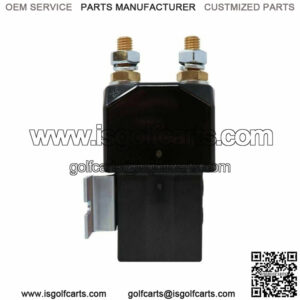Step #1: Locate The Starter Solenoid
To get started, locate your starter solenoid by following these simple steps:
Open Your Vehicle’s Hood
The car starter solenoid is located in your vehicle’s engine compartment. To gain access to it, pull the hood release handle near the driver’s door. When you finish, open the hood by releasing the safety latch on the front part of your vehicle.
Find The Starter
Your car’s positive battery cable connects directly to the starter. So, an easy way to find the car starter is to identify the positive terminal of the battery and then follow the positive battery cable.
Identify The Starter Solenoid
Once you’ve located the starter, you can now easily find the starter motor solenoid. This is the smaller cylinder attached to the top or side of the starter.
The starter motor solenoid has three connection points — two of these points are for the solenoid’s input and output terminals, while the other point is the control circuit terminal.
The input starter terminal carries a wire that connects the starter solenoid to the car battery. Meanwhile, the output starter terminal carries a thick wire that powers the starter motor.
So, now that you’ve located the starter solenoid, you can conduct a click test.
Step #2: Conduct A Click Test And Check The Battery
After finding the starter solenoid, conduct a click test to see if the solenoid works properly.
Here’s how:
Observe A Clicking Sound While Someone Turns On The Ignition Switch
Let someone turn on the starter switch while you stand near the engine. When the starter motor solenoid engages, you should hear a clicking sound.
If you hear a clicking sound but the starter motor isn’t moving, the solenoid could be engaging but not receiving enough battery power.
If there’s no sound, the starter solenoid is likely malfunctioning or you might have a dead car battery. In this case, you could test the battery to check if it indeed is the cause of your starter problem.
Here’s how you can test your car battery:
Test The Battery
If your starter fails to engage when you turn on the key switch, try testing your battery voltage using a voltmeter. Here’s how:
- Connect the positive (red) lead wire of the voltmeter to the battery’s positive terminal.
- Next, connect the negative (black) lead wire of the voltmeter to the battery’s negative terminal.
- Observe the voltmeter reading — the battery voltage should be around 12 volts before you start the vehicle. If the reading is below 12 Volts, or if there’s no reading at all, your battery might be too low or dead.
If your battery voltage is fine but the solenoid produces a weak clicking sound, try checking for current resistance in the control circuit. Here’s how you can do this:
Step #3: Test The Current From The Solenoid
When the starter solenoid produces a weak clicking sound, the fault could be with the control circuit or the solenoid.
To determine the cause of your starter problem, start by checking for current resistance in the control circuit.
Here’s how:
Check For Current Resistance Using A Jumper Wire
The thin wire connected to the solenoid — referred to as the ignition switch connection — helps complete the control circuit. This connection only has current when you turn on the ignition key or press the start button.
An easy way to test for resistance in this control circuit is by using a jumper cable to complete the circuit. Here’s how you can do this:
- Connect the jumper cable between the control circuit terminal (the ignition circuit lead) and the input solenoid terminal.
- Observe a solid clicking sound from the starter motor solenoid. If your connections are okay but you don’t hear any clicking sound, the starter solenoid could be faulty.
You can further use a test light to check if the starter solenoid is indeed the cause of your starter problem. Here’s how:
Check For Current Resistance Using A Test Light
To check for current resistance using a test light, here are the steps you could follow:
- Connect the red lead wire of the test light to the input solenoid terminal.
- Next, ground the black lead wire from the test light to any bare metal surface on your vehicle’s body. You could also use the negative terminal of the battery as a ground connection point.
- Now, observe the light — if it turns on, then the starter motor solenoid is receiving power from the battery.
- Next, check if the starter solenoid is transferring power properly. To do this, shift the test light’s red lead wire to the output solenoid terminal. However, keep the black lead grounded.
- Let someone turn on the ignition key or press the starter button. Observe the light — if it doesn’t turn on, the solenoid is likely failing to transfer power and might need replacement. However, if the light turns on but there’s no clicking sound or starter engagement, the issue lies with the car starter. To resolve this, you’ll need to get a starter replacement.
If the test light turns on but you hear a weak clicking sound, you might need to measure the voltage drop on the starter solenoid. Here’s how:
Step #4: Measure The Voltage Drop From The Solenoid
In case you hear a weak clicking sound when you turn on the key switch, the starter solenoid might be drawing insufficient power from the battery. In this case, you should check the voltage drop on the starter solenoid.
To check this, set your multimeter to 15 or 20 Volts on the DC Voltage scale. From there, here are the steps you could follow:
- Start by measuring the voltage drop from the battery. This will determine the amount of voltage drawn by the starter solenoid when it engages. To do this, connect the positive lead wire (red) of the multimeter to the positive terminal of the battery.
- Next, connect the negative lead wire (black) of the multimeter to the negative terminal of the battery.
- Observe the multimeter reading — your car battery should produce approximately 12 Volts when nothing is drawing power from it.
- While holding the multimeter, let someone turn on the ignition switch or press the starter button. If your battery has no issues, the voltage reading should drop from 12 Volts by approximately half a volt (0.5 Volts).
- Next, measure the voltage drop from the solenoid. To do this, place the multimeter’s positive lead wire on the output solenoid terminal. From there, place the multimeter’s negative lead wire on the input solenoid terminal.
- Finally, let someone turn on the ignition switch while you observe the voltage drop reading. The reading should match the voltage drop you measured on the battery (about 0.5 Volts). If the voltage drop is a match, then your starter problem is likely caused by the car starter and not the solenoid.

